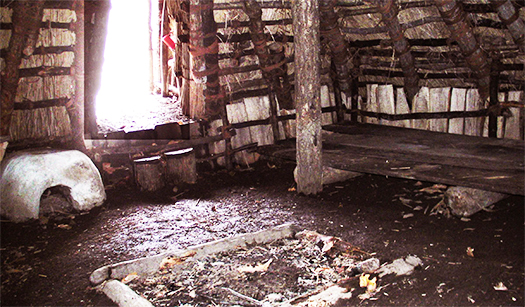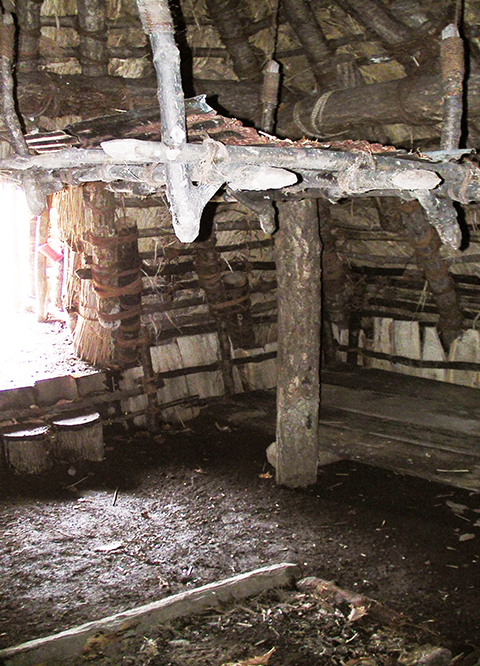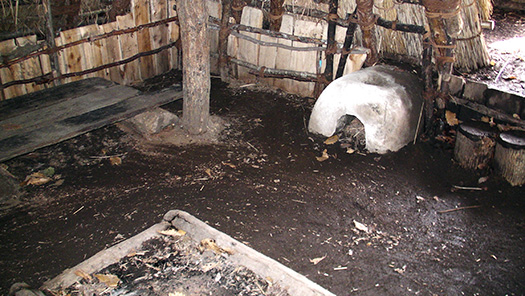


昨日に引き続き、擦文期(約1000年前当時の北海道島での時代区分)の竪穴住居。きのうは主に竪穴住居の土壌面の掘り下げ土木工事作業と、その「温熱的」人類知に沿ってまとめてみた。成員30名程度のムラ社会にとっての価値感を考えて見た次第。
それに対してこのブログの「協働者」とでも言えるShigeru Narabeさんから反応。いつも的確なポイント指摘でわたしの着目するテーマ領域に対しての啓示をもたらしてくれています。長文ですが、要旨は以下の通り。
「炊事道具一般を「鍋・釜」と呼ぶ。カマを据える処という言葉が恐らくカマドの語源。ナベにはツルというハンドルが着くのがデフォルトかと思う。全国にナベツル岩がある。ナベはツルで吊るのがデフォルトであろうと想像する。アイヌ文化は鉄ナベを吊る文化。住居にはカマドではなくてイロリがある。カマドではなくイロリを用いるのは、季節により住居を移動する身軽さと暖房とあわせた燃料効率の問題のようにも感じる。さて、常呂遺跡の竪穴住居跡はどうなのだろう?」<全文はhttps://www.facebook.com/replanmarke/ コメント欄をご覧ください。>
という指摘でしたので、本日はそのポイントの写真です。
みごとにカマドと囲炉裏が同居している。
室外に燃焼の煙を排出する「煙道」も持ったカマドが玄関脇に定置されている。一方で囲炉裏の上部には食物を保存乾燥させる用途の木組み器具が定置されている。ここから囲炉裏に向かって自在鉤が存在すれば囲炉裏に「暖房+調理」の機能を兼用させるアイヌ期文化となるところ。しかし、東大の常呂遺跡研究者の示唆であるのか、明確な鉄鍋などの吊り下げ構造「自在鉤」の呈示は見られない。時代的には本州地域から鉄鍋などの「文明利器」は相当程度の流入は想像できる平安・鎌倉の時代相だけれど。
実はアイヌ期になぜカマドが消滅したのか、北海道の考古研究者でも定説が認められないとされてきている。擦文期の人びととアイヌ期にはこのライフスタイルの大きな違いという謎が横たわっている。常識的に考えて擦文人とアイヌ民に継承性はあったと思えるのだけれど、いくつかの基本的ライフスタイル相での違いが明瞭なのだ。
この常呂遺跡には、その後のアイヌ期の痕跡は残されていないとされる。北海道の住宅情報人としては、考古研究者のさらなる研究の進展を期待している段階。
きのう触れた外周側の土留め的な板状素材が林立して、土間床面との明瞭な対比を見せている。そこから萱状の屋根・外壁素材が壁面を構成している。囲炉裏の裸火に照らされて浮き上がってくるこういうインテリア空間環境で、先人たちは日々の活動後の床に就いていた。どのような寝物語をして共同体成員たちは明日の活力を涵養したか、いっとき思いを巡らせていました。
English version⬇
1000 years ago in Hokkaido, “Kamado” and “Irori” – Tokoro-3
The contrast between the Aburibun period and the Ainu period lifestyle and culture. According to the results of research at the Tokoro site by the University of Tokyo, it was assumed that people cooked food in a kamado (a kind of cooking stove). In contrast, the Ainu period is characterized by hearths for both cooking and heating. The Ainu period is characterized by the use of hearths for both cooking and heating.
Continuing from yesterday, the pit dwellings of the Aburibun period (the period category on Hokkaido Island at that time about 1,000 years ago). Yesterday, I mainly summarized the excavation of the soil surface of the pit dwelling and its “thermal” anthropological knowledge. I thought about the sense of value for a village society of about 30 members.
Shigeru Narabe, who can be called the “collaborator” of this blog, responded. He has always made precise points that have brought revelations to the theme area I am focusing on. The following is the gist of his response, although it is lengthy.
The term “pot/kettle” refers to cooking utensils in general. The word “kamado” is probably derived from the word “kama,” which means a place to set up a kama. I think the default is to attach the handle “Tsuru” to the nabe. There are nabetsuru rocks all over the country. I imagine that the default is to hang the nabe with a crane. The Ainu culture is one of hanging iron nabes. The houses have irori, not kamado. The use of irori instead of kamado seems to be a matter of lightness in moving from one dwelling to another depending on the season, as well as fuel efficiency in combination with heating. Now, what about the pit dwelling sites at the Tsuneero site?
So today’s photo is of that point.
The kamado and the sunken hearth are beautifully coexisting in the same house.
The kamado, which also has a “flue” for discharging combustion smoke outside the house, is stationed by the entrance. On the top of the hearth is a wooden structure used to store and dry food. If a free hook was placed toward the hearth from here, it would indicate that the hearth served both heating and cooking functions in the Ainu culture. However, there is no clear indication of a “free hook” for hanging iron pots and pans, as suggested by researchers at the University of Tokyo’s Tsunero Site. Although it is possible to imagine a considerable influx of iron pots and other “civilized” tools from the Honshu area during the Heian and Kamakura periods, it is not clear why the Ainu culture would have been involved in the construction of these pots and pans.
In fact, even archaeologists in Hokkaido have been unable to come up with a definitive theory as to why the kamado disappeared during the Ainu period. The mystery lies in the great difference in lifestyle between the people of the Abrahamic period and the Ainu period. Although common sense would suggest that the Abrahamic people and the Ainu people were interrelated, there are some basic lifestyle differences that are clear.
It is believed that no traces of the later Ainu period were left at the Tsunero site. As a housing informant in Hokkaido, I am looking forward to further research by archaeologists.
The earth-roofed wooden planks on the outer perimeter of the house, which I mentioned yesterday, stand in sharp contrast to the earthen floor. From there, the roof and exterior walls are made up of grass-like materials. In this interior space environment, illuminated by the open fire of the sunken hearth, our ancestors slept on the floor after their daily activities. For a moment, I was thinking about what kind of bedtime stories the members of the community used to cultivate their vitality for tomorrow.
Posted on 10月 22nd, 2024 by 三木 奎吾
Filed under: 住宅取材&ウラ話, 歴史探訪







コメントを投稿
「※誹謗中傷や、悪意のある書き込み、営利目的などのコメントを防ぐために、投稿された全てのコメントは一時的に保留されますのでご了承ください。」
You must be logged in to post a comment.